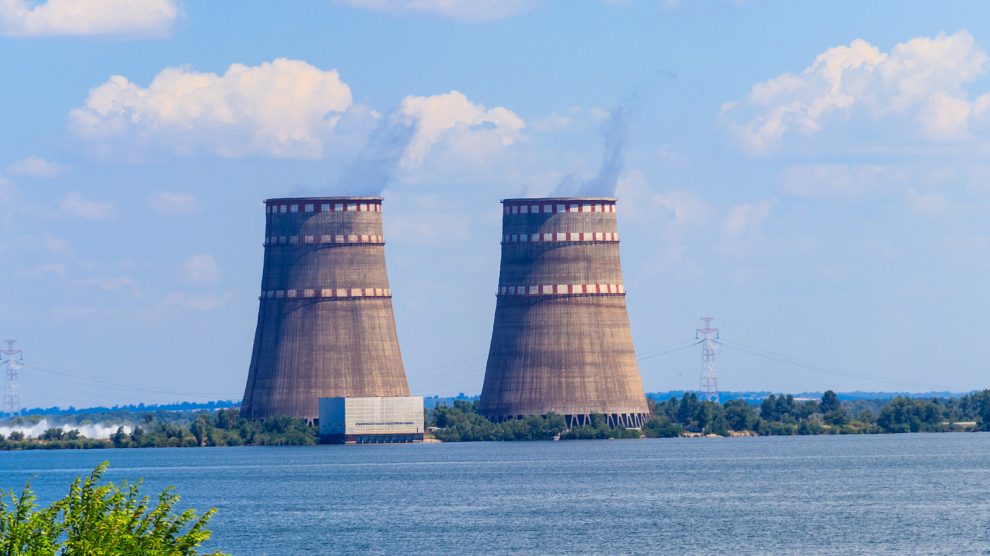Ukrainian counterintelligence this week reported that a possible terrorist attack is being prepared by Russian forces occupying Zaporizhzhia nuclear power plant. We ask a former plant employee about the possible consequences of such an attack.
For more than a year the nuclear power plant at Zaporizhzhia in southern Ukraine has been occupied by Russia. Located in the steppe zone on the banks of the Kakhovka reservoir near the city of Energodar, it is the largest nuclear power plant in Europe and the sixth largest in the world.
Last week, the head of Ukraine’s Main Intelligence Directorate, Kyrylo Budanov, caused global concern when he said that Russia had mined the pools that cool the six reactors at the plant.
- The limitless potential of Chernobyl: From a nuclear waste storage facility to a space laboratory
- Russia’s continuing stranglehold on emerging Europe’s nuclear sector
- What future for the Ukrainian energy sector?
On June 22, President Volodymyr Zelensky, citing intelligence reports, also said that Russia had “prepared everything” to commit a terrorist attack at Zaporizhzhia. The Ukrainian Foreign Ministry has said that such an attack would have “worldwide consequences”.
However, the International Atomic Energy Agency (IAEA) has stated that no mines were observed during a visit to the plant by its director general Rafael Grossi on June 16.
Hot and cold
Prior to the seizure of Zaporizhzhia by Russia, Timur Valieiev worked as a leading reactor control engineer at the plant’s Unit 6. Early in 2023, when the Russians began to force the plant’s specialists to sign contracts with its own nuclear energy agency, Rosatom, and obtain Russian passports, Valieiev left for Germany where he has since been working at Deutsches Elektronen-Synchrotron DESY in Hamburg.
Valieiev says that the power units at Zaporizhzhia have been shut down since September and are not currently producing electricity.
“The capacity at all six power units is zero at the moment,” he says. “This includes Unit 5, which is now of universal concern.”
Unit 5 continues to operate in what is known as “hot shutdown” mode to produce the steam needed for wastewater treatment, as well as the steam cooling system that provides air conditioning in control rooms important for nuclear safety. The five other power units are in a “cold shutdown” state.
The difference is in the temperature in the reactor’s primary circuit. In a cold state, the temperature is lower than 70 degrees Celsius. In a hot state, it is above 260 degrees Celsius.
“’Cold shutdown’ is the safe state of a nuclear reactor when it is shut down at low pressure and a low cooling water temperature,” says Valieiev. “It is the intermediate state of a nuclear reactor between operation and fuel overload. It can be in this state indefinitely as long as it is connected to an external power supply and cooled.
“‘Hot shutdown’ however is an intermediate mode between operation at minimum power and the cold state. In this case, without proper cooling or de-energising, an accident will occur faster than from the cold state.”
In hot shutdown mode, the temperature of the primary circuit is maintained by operating at least two main circulation pumps and regulating the degree of cooling through the heat exchangers of the cooling system.
Even when a reactor is not in operation, it is always connected to the scheduled cooling circuit. In this state, the fuel has no passive fission reaction, but has static release energy. Even the spent fuel is moved to a pool for five years, during which time it gradually cools down. The fuel is then dried for further storage in special containers.

‘A Russian hoax’
Valieiev says that he does not believe recent reports that the Russians have mined the water pools that cool the reactors. “Another Russian hoax,” he says.
He adds that there may also be other reactor cooling mechanisms at the plant, which could be used even if the Russians take the service water pools out of operation.
“Zaporizhzhia is designed in such a way that heat removal can take place in several different ways,” he says.
“Even if the Russians plan to stop cooling the reactors, we are talking about taking out more than one pool and more than one safety system that will automatically activate alternative cooling sources. It’s not that easy to do.”
Reassuringly, Valieiev adds that in an emergency situation, plant personnel have several backup options.
“After the accident at the Fukushima nuclear power plant in Japan in 2011, Zaporizhzhia was fitted with mobile pumping units, which have long hoses, like those on fire trucks, except that these are two kilometres long. They can be brought to the bank of the Dnieper and can pump water for the pools that cool the reactors.
“If the Russians do damage the cooling pools before they leave the plant, the Ukrainian specialists will know exactly what to do to cool the reactors.”
Vasiliev also suggests that the danger posed by mines placed in the engine rooms, where the turbines of the power units are located, have been overstated.
“The reactor itself, the reactor cooling the primary circuit, is in the reactor compartment. This compartment is separate and protected by powerful walls. If the engine room of one of the reactors explodes, the only consequence will be a major fire.”
Unlike many news and information platforms, Emerging Europe is free to read, and always will be. There is no paywall here. We are independent, not affiliated with nor representing any political party or business organisation. We want the very best for emerging Europe, nothing more, nothing less. Your support will help us continue to spread the word about this amazing region.
You can contribute here. Thank you.







Add Comment